Nursing Report: Communication with Intellectual Disability Patients
VerifiedAdded on 2022/12/08
|22
|4330
|463
Report
AI Summary
This nursing report critically evaluates the communication process when working with individuals with intellectual disabilities in an acute care setting. It explores the significance of nonverbal communication, recognizing that many individuals with intellectual disabilities rely on nonverbal cues to express themselves. The report justifies the importance of nonverbal communication skills for nurses, emphasizing the need for understanding and adapting to patients' communication styles. It outlines the skills of nonverbal communication, including facial expressions, gestures, and body language, and discusses how these can be applied in practice. The report also contextualizes nonverbal communication within the nursing care framework, highlighting the impact of environmental conditions, physical characteristics, and behaviors. Adult learning and communication models are examined, with a focus on how these models can be utilized to improve training sessions. The report also analyzes assumptions, implications, and consequences related to the education process and its benefits to staff. The report concludes with reflections on the development and skill of nonverbal communication.

NURSING – THINK BIG
STUDENT DETAILS
STUDENT DETAILS
Paraphrase This Document
Need a fresh take? Get an instant paraphrase of this document with our AI Paraphraser
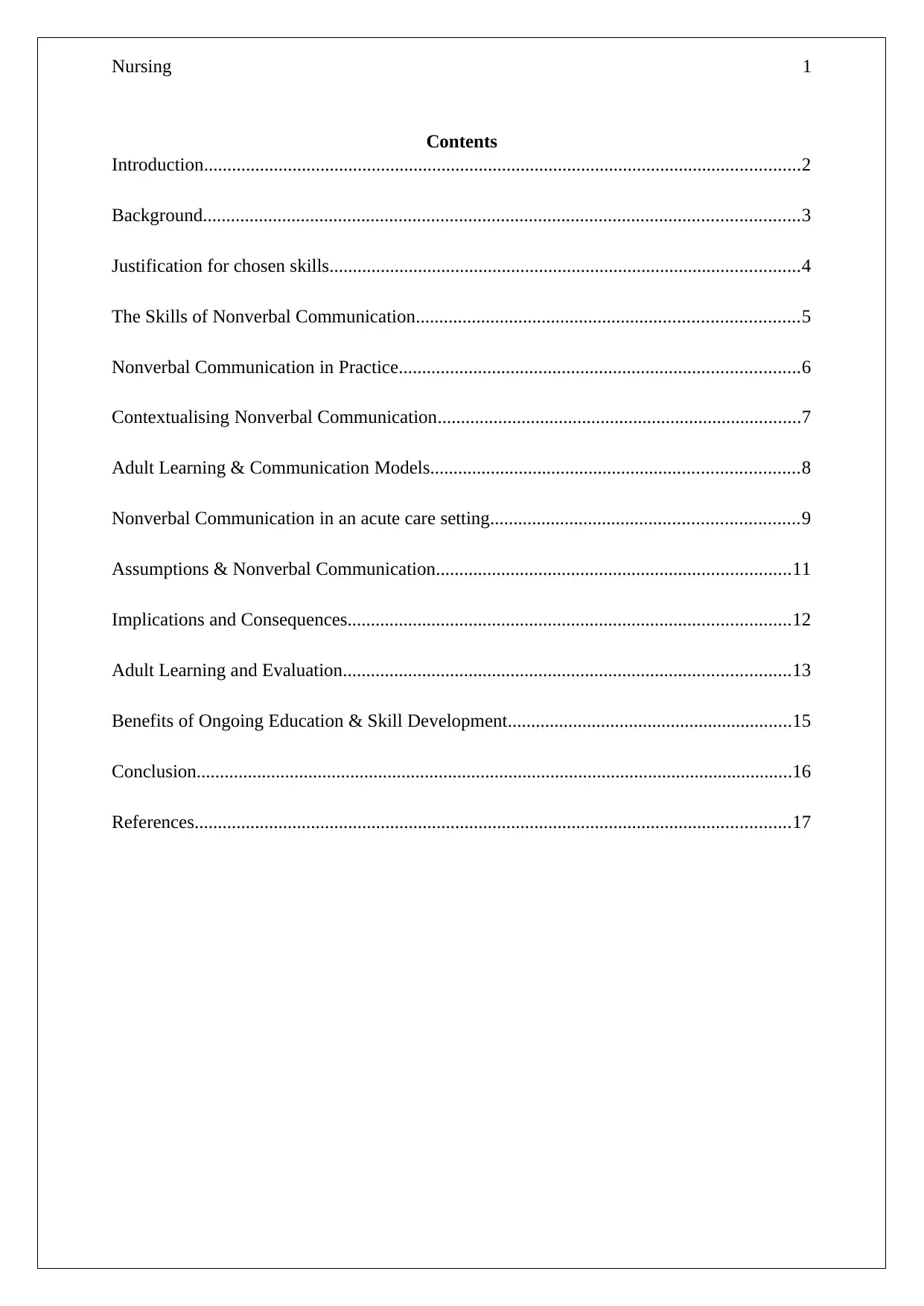
Nursing 1
Contents
Introduction................................................................................................................................2
Background................................................................................................................................3
Justification for chosen skills.....................................................................................................4
The Skills of Nonverbal Communication..................................................................................5
Nonverbal Communication in Practice......................................................................................6
Contextualising Nonverbal Communication..............................................................................7
Adult Learning & Communication Models...............................................................................8
Nonverbal Communication in an acute care setting..................................................................9
Assumptions & Nonverbal Communication............................................................................11
Implications and Consequences...............................................................................................12
Adult Learning and Evaluation................................................................................................13
Benefits of Ongoing Education & Skill Development.............................................................15
Conclusion................................................................................................................................16
References................................................................................................................................17
Contents
Introduction................................................................................................................................2
Background................................................................................................................................3
Justification for chosen skills.....................................................................................................4
The Skills of Nonverbal Communication..................................................................................5
Nonverbal Communication in Practice......................................................................................6
Contextualising Nonverbal Communication..............................................................................7
Adult Learning & Communication Models...............................................................................8
Nonverbal Communication in an acute care setting..................................................................9
Assumptions & Nonverbal Communication............................................................................11
Implications and Consequences...............................................................................................12
Adult Learning and Evaluation................................................................................................13
Benefits of Ongoing Education & Skill Development.............................................................15
Conclusion................................................................................................................................16
References................................................................................................................................17
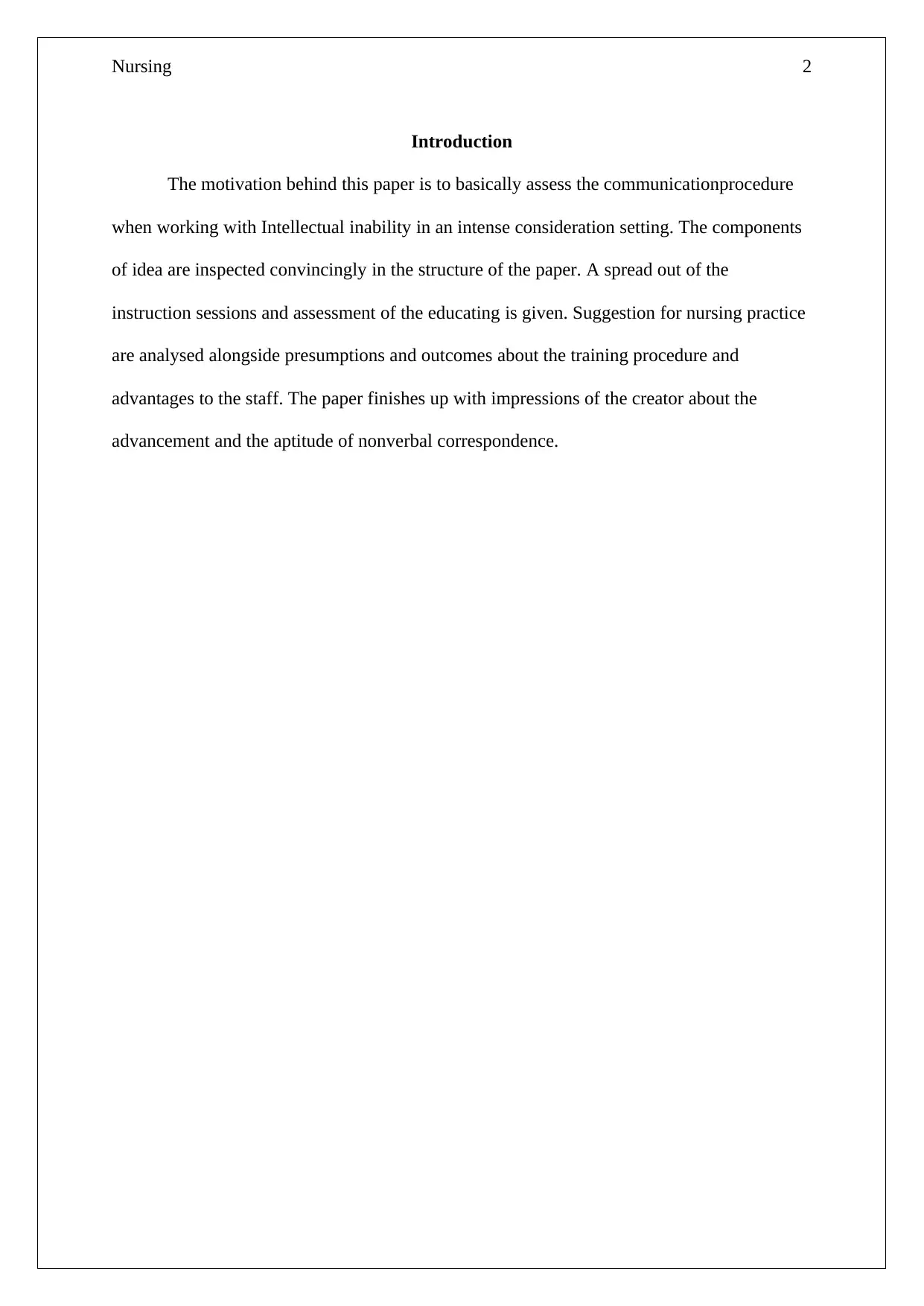
Nursing 2
Introduction
The motivation behind this paper is to basically assess the communicationprocedure
when working with Intellectual inability in an intense consideration setting. The components
of idea are inspected convincingly in the structure of the paper. A spread out of the
instruction sessions and assessment of the educating is given. Suggestion for nursing practice
are analysed alongside presumptions and outcomes about the training procedure and
advantages to the staff. The paper finishes up with impressions of the creator about the
advancement and the aptitude of nonverbal correspondence.
Introduction
The motivation behind this paper is to basically assess the communicationprocedure
when working with Intellectual inability in an intense consideration setting. The components
of idea are inspected convincingly in the structure of the paper. A spread out of the
instruction sessions and assessment of the educating is given. Suggestion for nursing practice
are analysed alongside presumptions and outcomes about the training procedure and
advantages to the staff. The paper finishes up with impressions of the creator about the
advancement and the aptitude of nonverbal correspondence.
⊘ This is a preview!⊘
Do you want full access?
Subscribe today to unlock all pages.

Trusted by 1+ million students worldwide
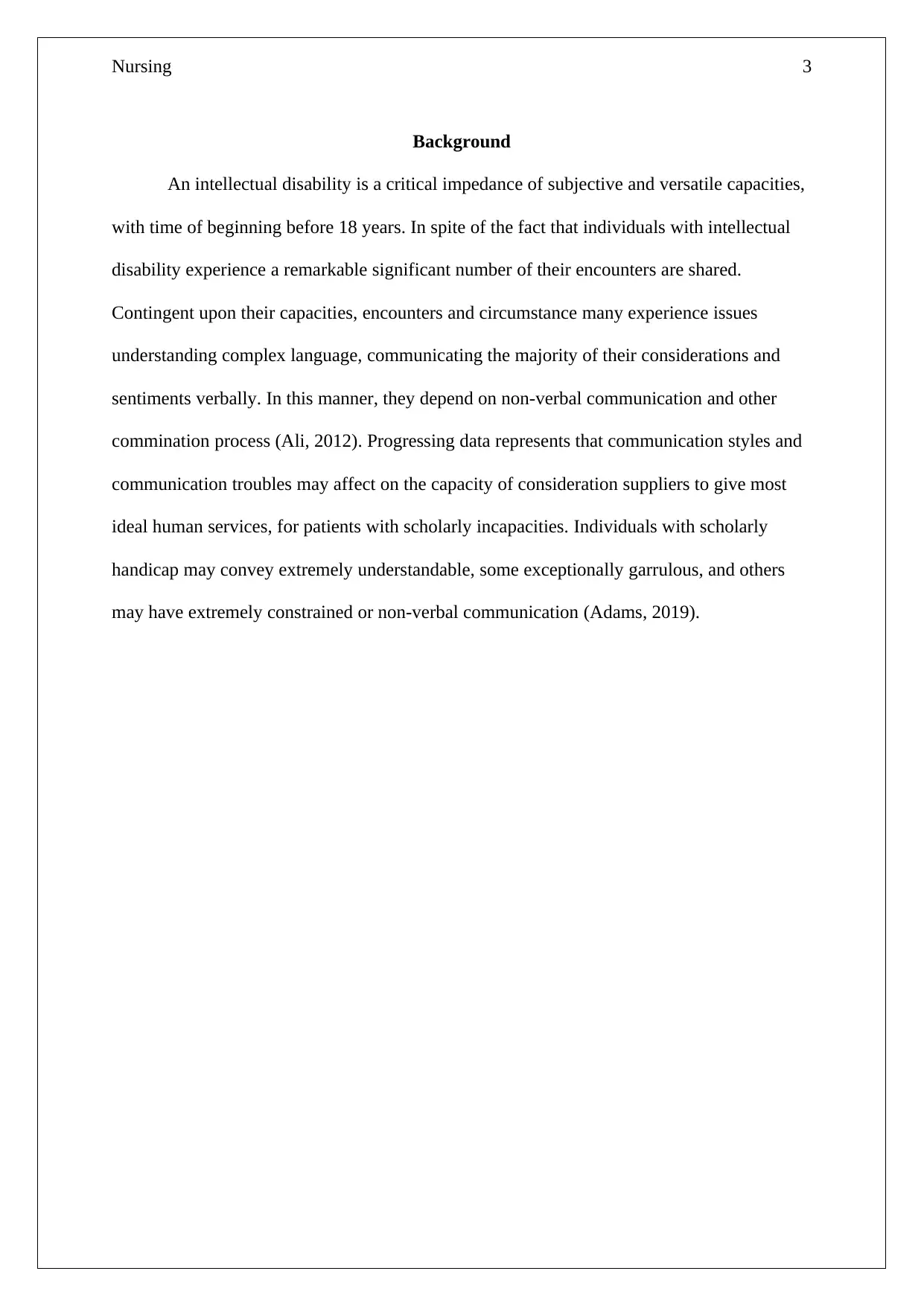
Nursing 3
Background
An intellectual disability is a critical impedance of subjective and versatile capacities,
with time of beginning before 18 years. In spite of the fact that individuals with intellectual
disability experience a remarkable significant number of their encounters are shared.
Contingent upon their capacities, encounters and circumstance many experience issues
understanding complex language, communicating the majority of their considerations and
sentiments verbally. In this manner, they depend on non-verbal communication and other
commination process (Ali, 2012). Progressing data represents that communication styles and
communication troubles may affect on the capacity of consideration suppliers to give most
ideal human services, for patients with scholarly incapacities. Individuals with scholarly
handicap may convey extremely understandable, some exceptionally garrulous, and others
may have extremely constrained or non-verbal communication (Adams, 2019).
Background
An intellectual disability is a critical impedance of subjective and versatile capacities,
with time of beginning before 18 years. In spite of the fact that individuals with intellectual
disability experience a remarkable significant number of their encounters are shared.
Contingent upon their capacities, encounters and circumstance many experience issues
understanding complex language, communicating the majority of their considerations and
sentiments verbally. In this manner, they depend on non-verbal communication and other
commination process (Ali, 2012). Progressing data represents that communication styles and
communication troubles may affect on the capacity of consideration suppliers to give most
ideal human services, for patients with scholarly incapacities. Individuals with scholarly
handicap may convey extremely understandable, some exceptionally garrulous, and others
may have extremely constrained or non-verbal communication (Adams, 2019).
Paraphrase This Document
Need a fresh take? Get an instant paraphrase of this document with our AI Paraphraser
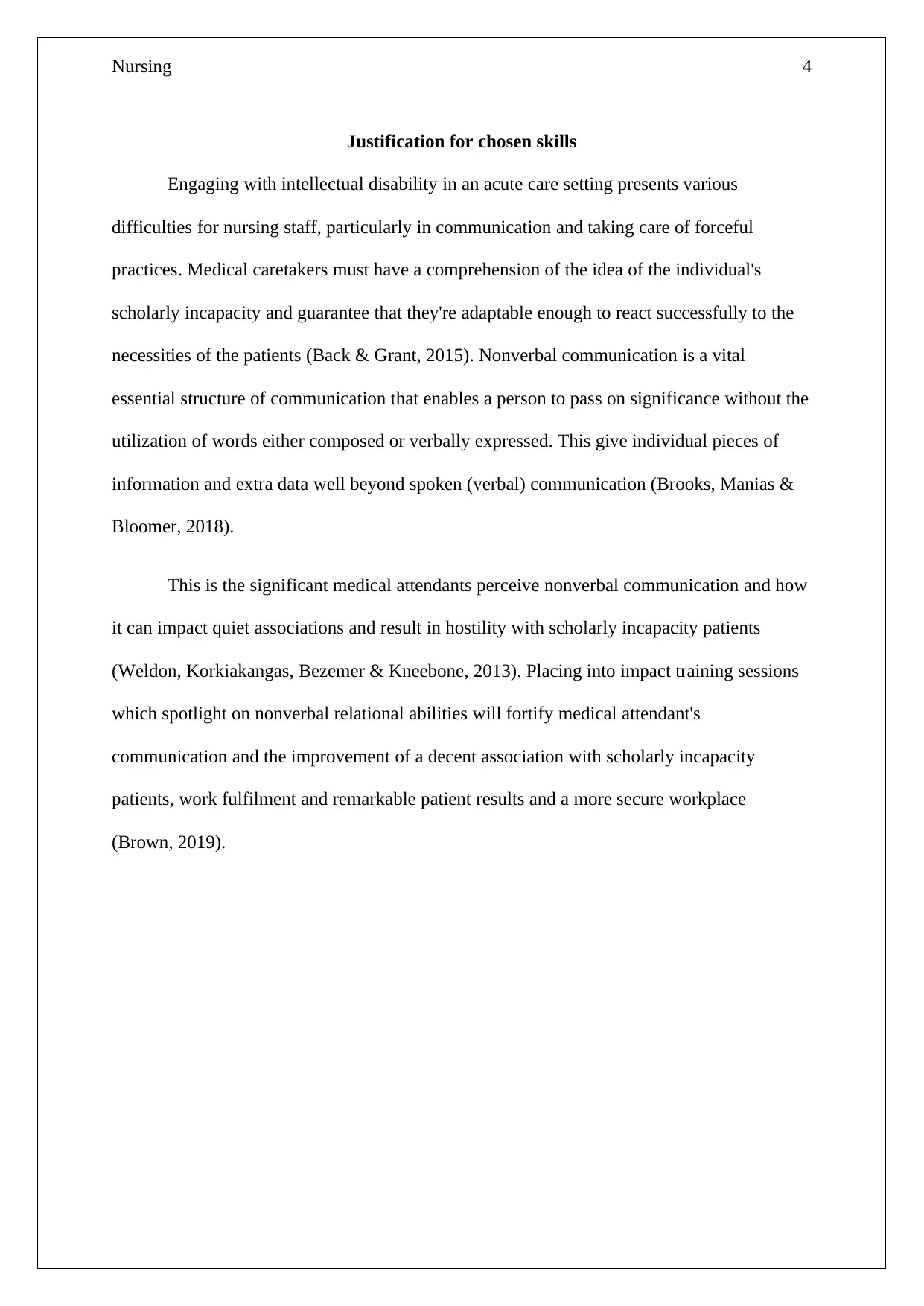
Nursing 4
Justification for chosen skills
Engaging with intellectual disability in an acute care setting presents various
difficulties for nursing staff, particularly in communication and taking care of forceful
practices. Medical caretakers must have a comprehension of the idea of the individual's
scholarly incapacity and guarantee that they're adaptable enough to react successfully to the
necessities of the patients (Back & Grant, 2015). Nonverbal communication is a vital
essential structure of communication that enables a person to pass on significance without the
utilization of words either composed or verbally expressed. This give individual pieces of
information and extra data well beyond spoken (verbal) communication (Brooks, Manias &
Bloomer, 2018).
This is the significant medical attendants perceive nonverbal communication and how
it can impact quiet associations and result in hostility with scholarly incapacity patients
(Weldon, Korkiakangas, Bezemer & Kneebone, 2013). Placing into impact training sessions
which spotlight on nonverbal relational abilities will fortify medical attendant's
communication and the improvement of a decent association with scholarly incapacity
patients, work fulfilment and remarkable patient results and a more secure workplace
(Brown, 2019).
Justification for chosen skills
Engaging with intellectual disability in an acute care setting presents various
difficulties for nursing staff, particularly in communication and taking care of forceful
practices. Medical caretakers must have a comprehension of the idea of the individual's
scholarly incapacity and guarantee that they're adaptable enough to react successfully to the
necessities of the patients (Back & Grant, 2015). Nonverbal communication is a vital
essential structure of communication that enables a person to pass on significance without the
utilization of words either composed or verbally expressed. This give individual pieces of
information and extra data well beyond spoken (verbal) communication (Brooks, Manias &
Bloomer, 2018).
This is the significant medical attendants perceive nonverbal communication and how
it can impact quiet associations and result in hostility with scholarly incapacity patients
(Weldon, Korkiakangas, Bezemer & Kneebone, 2013). Placing into impact training sessions
which spotlight on nonverbal relational abilities will fortify medical attendant's
communication and the improvement of a decent association with scholarly incapacity
patients, work fulfilment and remarkable patient results and a more secure workplace
(Brown, 2019).

Nursing 5
The Skills of Nonverbal Communication
The capacity to impart is a significant aptitude and imperative in sharing data and
builds up a typical comprehension. Dissimilar to the verbal communication which just help in
conveying the outside occasions. The Non-Verbal Communication, helps in setting up and
keeping up the relational connections. This incorporates outward appearances, hand
developments, non-verbal communication, stances and motions (Burnard & Grill, 2014).
Non-verbal communication is regularly viewed as the more dominant than verbal and
experiencing issues with communication are a noteworthy obstruction to individuals with
scholarly handicap. Non-verbal is the most piece of correspondence, that just about 7% of it
is involved communicated in language. Of the staying 93%, manner of speaking records for
about 38% while the staying 55% is included five noteworthy nonverbal territories arranged
by development, separation, time, utilization of the eyes, and contact (Douglas, et. al., 2014).
Medical attendants must comprehend that adjustment in individuals with scholarly
inability normal conduct could demonstrate that they are trying to change some piece of their
inner or outer condition. Testing conduct ought to be seen as a type of communication
(Eggenberger, Heimerl & Bennett, 2013).
The Skills of Nonverbal Communication
The capacity to impart is a significant aptitude and imperative in sharing data and
builds up a typical comprehension. Dissimilar to the verbal communication which just help in
conveying the outside occasions. The Non-Verbal Communication, helps in setting up and
keeping up the relational connections. This incorporates outward appearances, hand
developments, non-verbal communication, stances and motions (Burnard & Grill, 2014).
Non-verbal communication is regularly viewed as the more dominant than verbal and
experiencing issues with communication are a noteworthy obstruction to individuals with
scholarly handicap. Non-verbal is the most piece of correspondence, that just about 7% of it
is involved communicated in language. Of the staying 93%, manner of speaking records for
about 38% while the staying 55% is included five noteworthy nonverbal territories arranged
by development, separation, time, utilization of the eyes, and contact (Douglas, et. al., 2014).
Medical attendants must comprehend that adjustment in individuals with scholarly
inability normal conduct could demonstrate that they are trying to change some piece of their
inner or outer condition. Testing conduct ought to be seen as a type of communication
(Eggenberger, Heimerl & Bennett, 2013).
⊘ This is a preview!⊘
Do you want full access?
Subscribe today to unlock all pages.

Trusted by 1+ million students worldwide
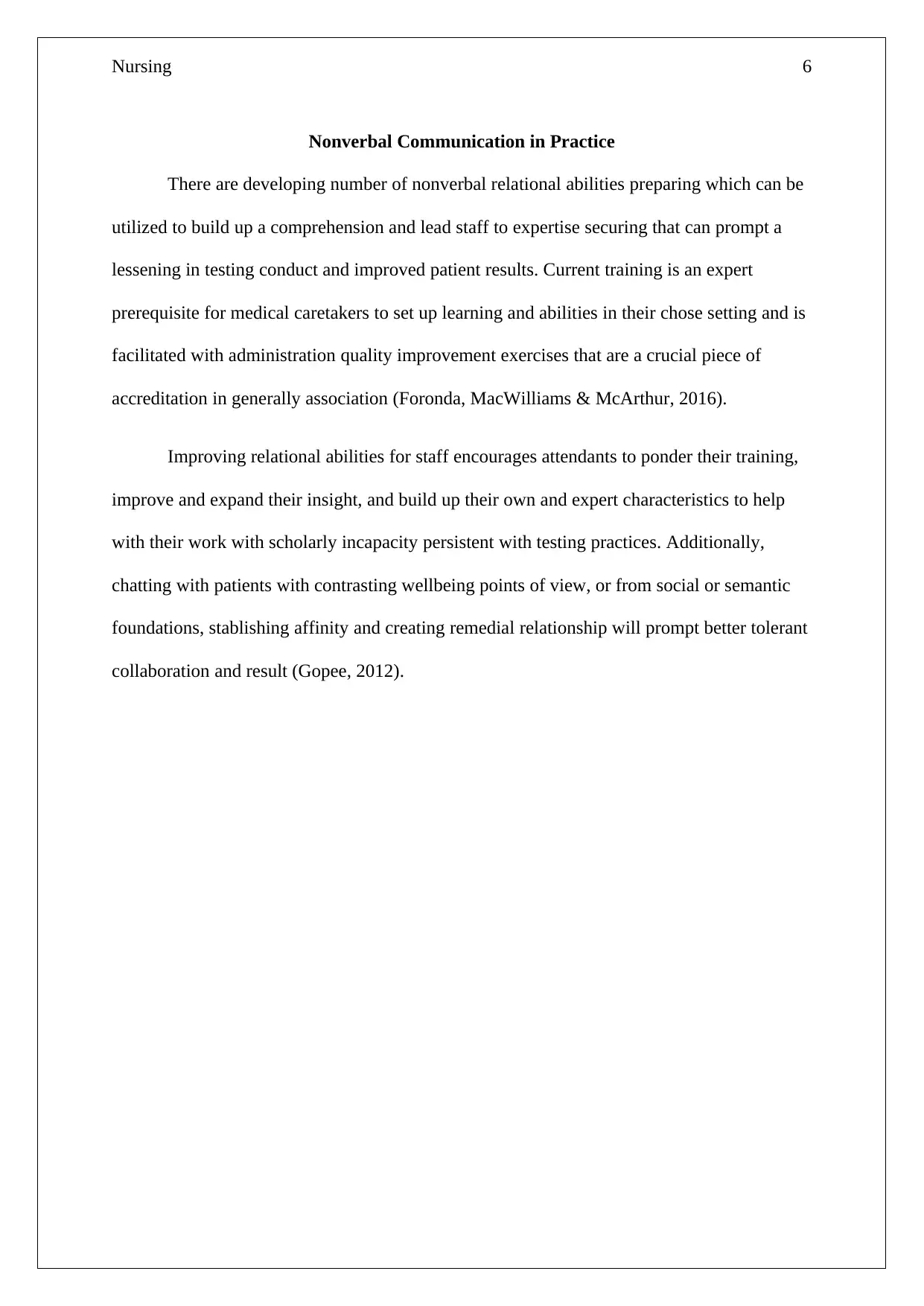
Nursing 6
Nonverbal Communication in Practice
There are developing number of nonverbal relational abilities preparing which can be
utilized to build up a comprehension and lead staff to expertise securing that can prompt a
lessening in testing conduct and improved patient results. Current training is an expert
prerequisite for medical caretakers to set up learning and abilities in their chose setting and is
facilitated with administration quality improvement exercises that are a crucial piece of
accreditation in generally association (Foronda, MacWilliams & McArthur, 2016).
Improving relational abilities for staff encourages attendants to ponder their training,
improve and expand their insight, and build up their own and expert characteristics to help
with their work with scholarly incapacity persistent with testing practices. Additionally,
chatting with patients with contrasting wellbeing points of view, or from social or semantic
foundations, stablishing affinity and creating remedial relationship will prompt better tolerant
collaboration and result (Gopee, 2012).
Nonverbal Communication in Practice
There are developing number of nonverbal relational abilities preparing which can be
utilized to build up a comprehension and lead staff to expertise securing that can prompt a
lessening in testing conduct and improved patient results. Current training is an expert
prerequisite for medical caretakers to set up learning and abilities in their chose setting and is
facilitated with administration quality improvement exercises that are a crucial piece of
accreditation in generally association (Foronda, MacWilliams & McArthur, 2016).
Improving relational abilities for staff encourages attendants to ponder their training,
improve and expand their insight, and build up their own and expert characteristics to help
with their work with scholarly incapacity persistent with testing practices. Additionally,
chatting with patients with contrasting wellbeing points of view, or from social or semantic
foundations, stablishing affinity and creating remedial relationship will prompt better tolerant
collaboration and result (Gopee, 2012).
Paraphrase This Document
Need a fresh take? Get an instant paraphrase of this document with our AI Paraphraser
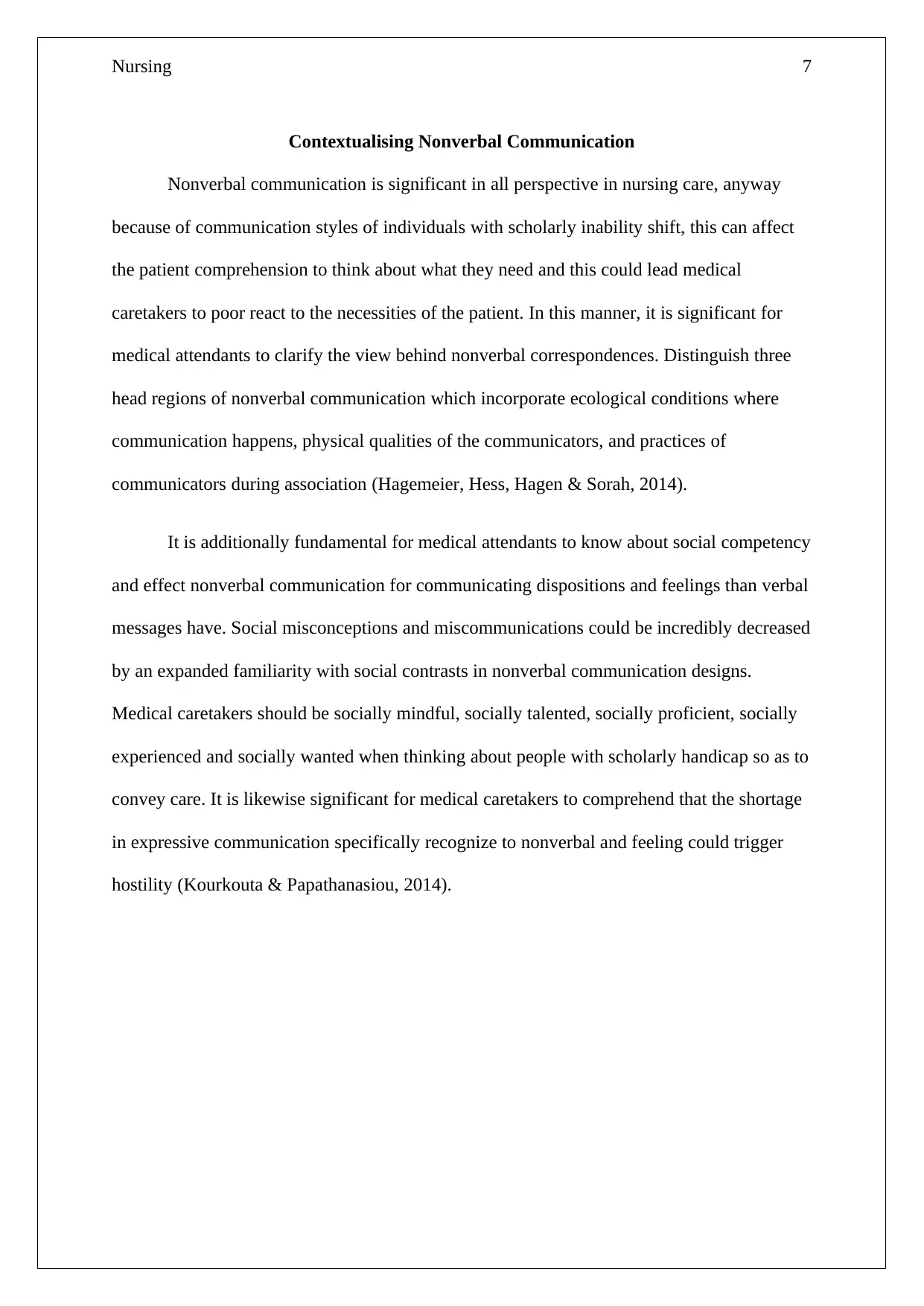
Nursing 7
Contextualising Nonverbal Communication
Nonverbal communication is significant in all perspective in nursing care, anyway
because of communication styles of individuals with scholarly inability shift, this can affect
the patient comprehension to think about what they need and this could lead medical
caretakers to poor react to the necessities of the patient. In this manner, it is significant for
medical attendants to clarify the view behind nonverbal correspondences. Distinguish three
head regions of nonverbal communication which incorporate ecological conditions where
communication happens, physical qualities of the communicators, and practices of
communicators during association (Hagemeier, Hess, Hagen & Sorah, 2014).
It is additionally fundamental for medical attendants to know about social competency
and effect nonverbal communication for communicating dispositions and feelings than verbal
messages have. Social misconceptions and miscommunications could be incredibly decreased
by an expanded familiarity with social contrasts in nonverbal communication designs.
Medical caretakers should be socially mindful, socially talented, socially proficient, socially
experienced and socially wanted when thinking about people with scholarly handicap so as to
convey care. It is likewise significant for medical caretakers to comprehend that the shortage
in expressive communication specifically recognize to nonverbal and feeling could trigger
hostility (Kourkouta & Papathanasiou, 2014).
Contextualising Nonverbal Communication
Nonverbal communication is significant in all perspective in nursing care, anyway
because of communication styles of individuals with scholarly inability shift, this can affect
the patient comprehension to think about what they need and this could lead medical
caretakers to poor react to the necessities of the patient. In this manner, it is significant for
medical attendants to clarify the view behind nonverbal correspondences. Distinguish three
head regions of nonverbal communication which incorporate ecological conditions where
communication happens, physical qualities of the communicators, and practices of
communicators during association (Hagemeier, Hess, Hagen & Sorah, 2014).
It is additionally fundamental for medical attendants to know about social competency
and effect nonverbal communication for communicating dispositions and feelings than verbal
messages have. Social misconceptions and miscommunications could be incredibly decreased
by an expanded familiarity with social contrasts in nonverbal communication designs.
Medical caretakers should be socially mindful, socially talented, socially proficient, socially
experienced and socially wanted when thinking about people with scholarly handicap so as to
convey care. It is likewise significant for medical caretakers to comprehend that the shortage
in expressive communication specifically recognize to nonverbal and feeling could trigger
hostility (Kourkouta & Papathanasiou, 2014).
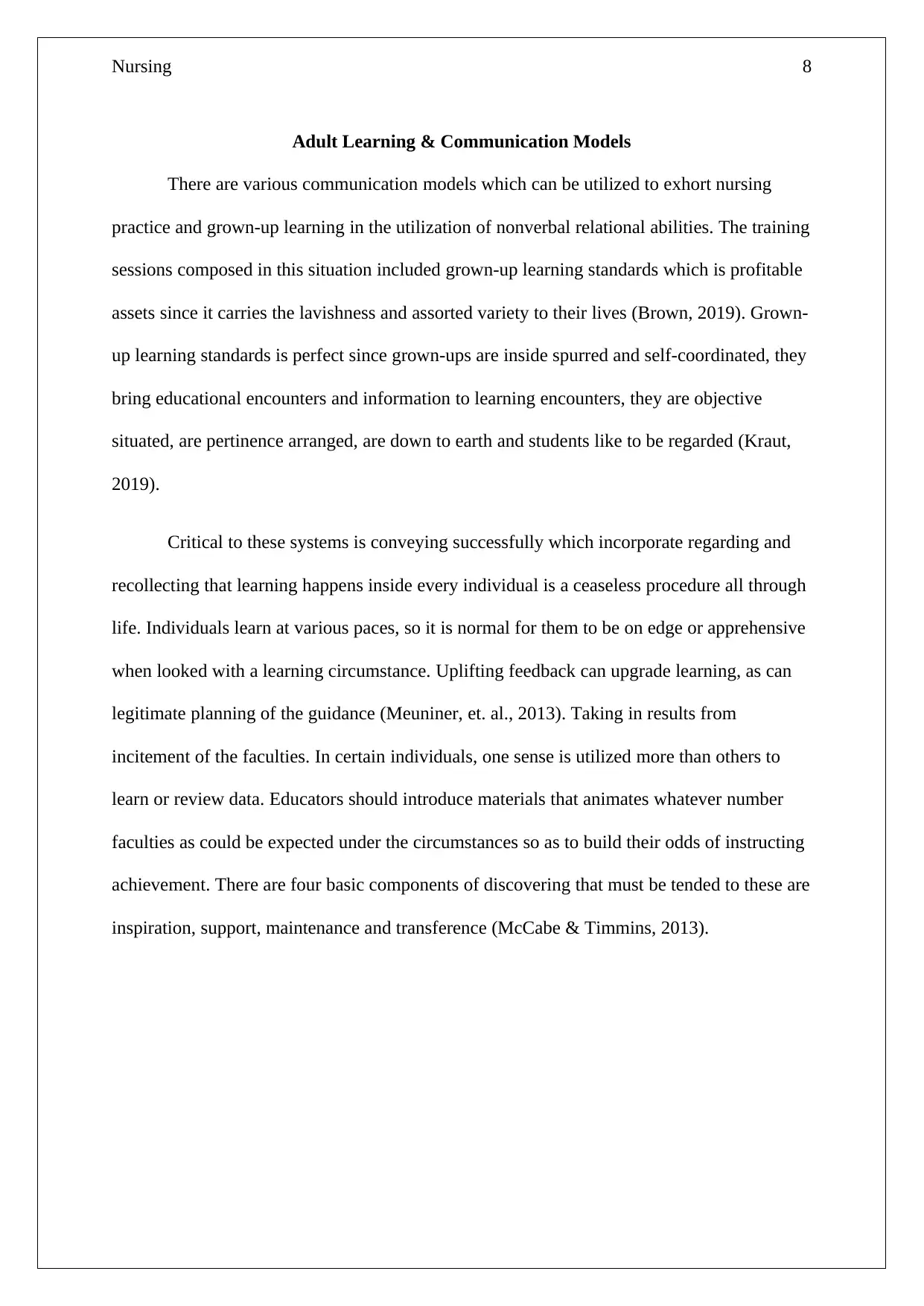
Nursing 8
Adult Learning & Communication Models
There are various communication models which can be utilized to exhort nursing
practice and grown-up learning in the utilization of nonverbal relational abilities. The training
sessions composed in this situation included grown-up learning standards which is profitable
assets since it carries the lavishness and assorted variety to their lives (Brown, 2019). Grown-
up learning standards is perfect since grown-ups are inside spurred and self-coordinated, they
bring educational encounters and information to learning encounters, they are objective
situated, are pertinence arranged, are down to earth and students like to be regarded (Kraut,
2019).
Critical to these systems is conveying successfully which incorporate regarding and
recollecting that learning happens inside every individual is a ceaseless procedure all through
life. Individuals learn at various paces, so it is normal for them to be on edge or apprehensive
when looked with a learning circumstance. Uplifting feedback can upgrade learning, as can
legitimate planning of the guidance (Meuniner, et. al., 2013). Taking in results from
incitement of the faculties. In certain individuals, one sense is utilized more than others to
learn or review data. Educators should introduce materials that animates whatever number
faculties as could be expected under the circumstances so as to build their odds of instructing
achievement. There are four basic components of discovering that must be tended to these are
inspiration, support, maintenance and transference (McCabe & Timmins, 2013).
Adult Learning & Communication Models
There are various communication models which can be utilized to exhort nursing
practice and grown-up learning in the utilization of nonverbal relational abilities. The training
sessions composed in this situation included grown-up learning standards which is profitable
assets since it carries the lavishness and assorted variety to their lives (Brown, 2019). Grown-
up learning standards is perfect since grown-ups are inside spurred and self-coordinated, they
bring educational encounters and information to learning encounters, they are objective
situated, are pertinence arranged, are down to earth and students like to be regarded (Kraut,
2019).
Critical to these systems is conveying successfully which incorporate regarding and
recollecting that learning happens inside every individual is a ceaseless procedure all through
life. Individuals learn at various paces, so it is normal for them to be on edge or apprehensive
when looked with a learning circumstance. Uplifting feedback can upgrade learning, as can
legitimate planning of the guidance (Meuniner, et. al., 2013). Taking in results from
incitement of the faculties. In certain individuals, one sense is utilized more than others to
learn or review data. Educators should introduce materials that animates whatever number
faculties as could be expected under the circumstances so as to build their odds of instructing
achievement. There are four basic components of discovering that must be tended to these are
inspiration, support, maintenance and transference (McCabe & Timmins, 2013).
⊘ This is a preview!⊘
Do you want full access?
Subscribe today to unlock all pages.

Trusted by 1+ million students worldwide

Nursing 9
Nonverbal Communication in an acute care setting
Thinking about scholarly inability in an intense consideration setting is both facing
and compensating however loaded up with a scope of troubles as talked about. It is
fundamental that all medical attendants have a more noteworthy familiarity with scholarly
handicaps just as they have to have a more noteworthy consciousness of how to build open
doors for successful correspondence. Specifically, individuals with scholarly handicap can
prompt change in conduct which can prompt issues for themselves or others, working
environment and clinic. Viable communication assumes a helpful job all through a patient's
whole social insurance experience, and a huge segment of the obligation falls on medical
attendants. This is a huge boundary when working with scholarly inability as they don't have
both verbal and far reaching abilities (Mulder, Lokhorst, Rutten & van, 2015).
In an Intellectual inability intense consideration setting the raised issues can meddle
on customer association and impishly affect medical caretakers interfacing with patients as
they can be occupied and hence not enable enough time for a patient to disclose their issues.
This can be a precarious circumstance for scholarly impaired patients as they need time to
adjust and have their needs considered. Be that as it may, if the medical caretakers don't
possess energy for them, this may add to going up against conduct because of dissatisfaction.
Mentally incapacitated patient who can't impart intentionally pass on their insight into inward
or outside boosts through their change in conduct. The complaint and ability progress for
attendants is to ensure nonverbal signs are coordinated into communication (Nørgaard,
Ammentorpm Ohm Kyvik & Kofoed, 2012).
It is obvious from the issues introduced there is a lot to recognize with respect to
nonverbal communication and nursing scholarly handicapped patients. With issues and
subjects distinguished in the writing the point of convergence of instruction was to set up
Nonverbal Communication in an acute care setting
Thinking about scholarly inability in an intense consideration setting is both facing
and compensating however loaded up with a scope of troubles as talked about. It is
fundamental that all medical attendants have a more noteworthy familiarity with scholarly
handicaps just as they have to have a more noteworthy consciousness of how to build open
doors for successful correspondence. Specifically, individuals with scholarly handicap can
prompt change in conduct which can prompt issues for themselves or others, working
environment and clinic. Viable communication assumes a helpful job all through a patient's
whole social insurance experience, and a huge segment of the obligation falls on medical
attendants. This is a huge boundary when working with scholarly inability as they don't have
both verbal and far reaching abilities (Mulder, Lokhorst, Rutten & van, 2015).
In an Intellectual inability intense consideration setting the raised issues can meddle
on customer association and impishly affect medical caretakers interfacing with patients as
they can be occupied and hence not enable enough time for a patient to disclose their issues.
This can be a precarious circumstance for scholarly impaired patients as they need time to
adjust and have their needs considered. Be that as it may, if the medical caretakers don't
possess energy for them, this may add to going up against conduct because of dissatisfaction.
Mentally incapacitated patient who can't impart intentionally pass on their insight into inward
or outside boosts through their change in conduct. The complaint and ability progress for
attendants is to ensure nonverbal signs are coordinated into communication (Nørgaard,
Ammentorpm Ohm Kyvik & Kofoed, 2012).
It is obvious from the issues introduced there is a lot to recognize with respect to
nonverbal communication and nursing scholarly handicapped patients. With issues and
subjects distinguished in the writing the point of convergence of instruction was to set up
Paraphrase This Document
Need a fresh take? Get an instant paraphrase of this document with our AI Paraphraser

Nursing 10
attention to nonverbal relational abilities when working with scholarly handicapped patients
and set up together the principle parts of nonverbal communication into the training session.
This demonstrates the accentuation of recognizing nonverbal communication in the arranged
consideration with scholarly incapacitated patients, diminishing forceful practices in the work
environment (Norouzinia, Aghabarai, Shiri, Karimi & Samami, 2016).
The fundamental element given other than change in conduct incorporate outward
appearance and non-verbal communication (Rnbsnonline.um.edu, 2019). These components
are significant when working with scholarly debilitated patients and would call attention to
the significance of training sessions, the death of learning and momentum skilling of nursing
staff to consolidate their investigation without hesitation (Riess & Kraft-Todd, 2014).
attention to nonverbal relational abilities when working with scholarly handicapped patients
and set up together the principle parts of nonverbal communication into the training session.
This demonstrates the accentuation of recognizing nonverbal communication in the arranged
consideration with scholarly incapacitated patients, diminishing forceful practices in the work
environment (Norouzinia, Aghabarai, Shiri, Karimi & Samami, 2016).
The fundamental element given other than change in conduct incorporate outward
appearance and non-verbal communication (Rnbsnonline.um.edu, 2019). These components
are significant when working with scholarly debilitated patients and would call attention to
the significance of training sessions, the death of learning and momentum skilling of nursing
staff to consolidate their investigation without hesitation (Riess & Kraft-Todd, 2014).
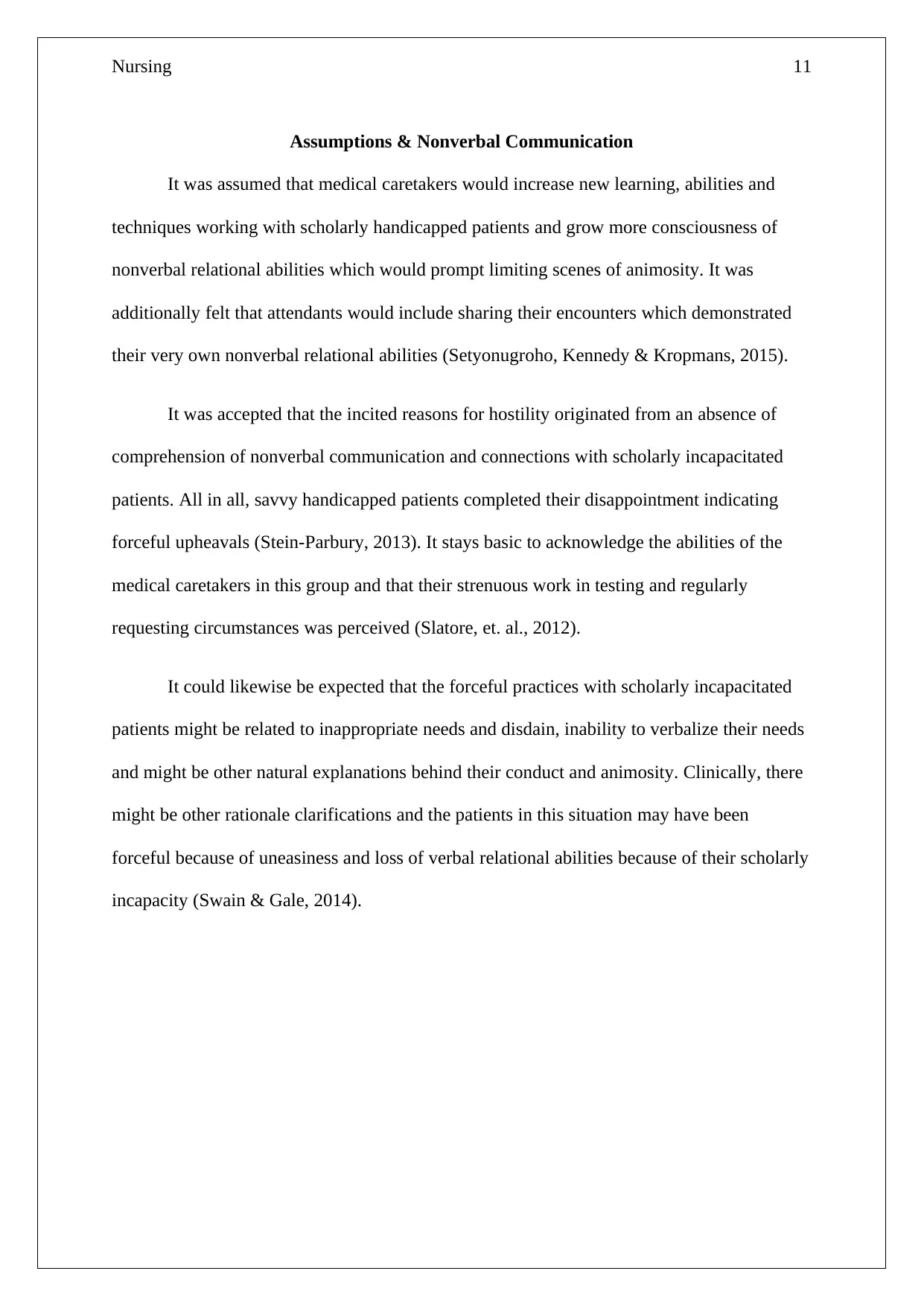
Nursing 11
Assumptions & Nonverbal Communication
It was assumed that medical caretakers would increase new learning, abilities and
techniques working with scholarly handicapped patients and grow more consciousness of
nonverbal relational abilities which would prompt limiting scenes of animosity. It was
additionally felt that attendants would include sharing their encounters which demonstrated
their very own nonverbal relational abilities (Setyonugroho, Kennedy & Kropmans, 2015).
It was accepted that the incited reasons for hostility originated from an absence of
comprehension of nonverbal communication and connections with scholarly incapacitated
patients. All in all, savvy handicapped patients completed their disappointment indicating
forceful upheavals (Stein-Parbury, 2013). It stays basic to acknowledge the abilities of the
medical caretakers in this group and that their strenuous work in testing and regularly
requesting circumstances was perceived (Slatore, et. al., 2012).
It could likewise be expected that the forceful practices with scholarly incapacitated
patients might be related to inappropriate needs and disdain, inability to verbalize their needs
and might be other natural explanations behind their conduct and animosity. Clinically, there
might be other rationale clarifications and the patients in this situation may have been
forceful because of uneasiness and loss of verbal relational abilities because of their scholarly
incapacity (Swain & Gale, 2014).
Assumptions & Nonverbal Communication
It was assumed that medical caretakers would increase new learning, abilities and
techniques working with scholarly handicapped patients and grow more consciousness of
nonverbal relational abilities which would prompt limiting scenes of animosity. It was
additionally felt that attendants would include sharing their encounters which demonstrated
their very own nonverbal relational abilities (Setyonugroho, Kennedy & Kropmans, 2015).
It was accepted that the incited reasons for hostility originated from an absence of
comprehension of nonverbal communication and connections with scholarly incapacitated
patients. All in all, savvy handicapped patients completed their disappointment indicating
forceful upheavals (Stein-Parbury, 2013). It stays basic to acknowledge the abilities of the
medical caretakers in this group and that their strenuous work in testing and regularly
requesting circumstances was perceived (Slatore, et. al., 2012).
It could likewise be expected that the forceful practices with scholarly incapacitated
patients might be related to inappropriate needs and disdain, inability to verbalize their needs
and might be other natural explanations behind their conduct and animosity. Clinically, there
might be other rationale clarifications and the patients in this situation may have been
forceful because of uneasiness and loss of verbal relational abilities because of their scholarly
incapacity (Swain & Gale, 2014).
⊘ This is a preview!⊘
Do you want full access?
Subscribe today to unlock all pages.

Trusted by 1+ million students worldwide
1 out of 22
Your All-in-One AI-Powered Toolkit for Academic Success.
+13062052269
info@desklib.com
Available 24*7 on WhatsApp / Email
![[object Object]](/_next/static/media/star-bottom.7253800d.svg)
Unlock your academic potential
Copyright © 2020–2025 A2Z Services. All Rights Reserved. Developed and managed by ZUCOL.


